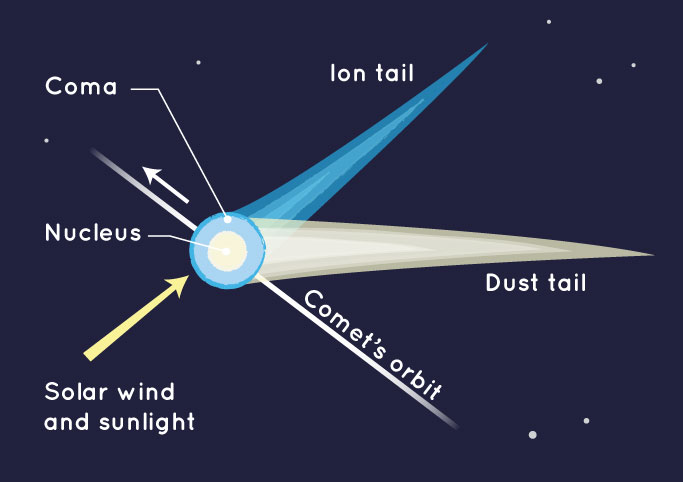
The Coma of a Comet: Unveiling the Mysteries of a Celestial Beauty
Comets have long fascinated humanity with their ethereal tails and luminous apparitions in the night sky. One of the most enigmatic features of a comet is its “coma,” a glowing, diffuse cloud that surrounds the comet’s nucleus. In this comprehensive article, we will explore the nature of a comet’s coma, its formation, composition, and the scientific insights it provides into the early universe.
What is the Coma of a Comet?
The coma of a comet is a nebulous, glowing envelope of gas and dust that envelops the central nucleus of the comet. It is typically spherical in shape and can extend for thousands to millions of kilometers into space. The coma is illuminated by the Sun, which causes it to glow and become visible from Earth.
Formation of a Coma
The formation of a comet’s coma is a complex process influenced by various factors, primarily driven by the Sun’s energy. Here’s a step-by-step explanation of how a coma forms:
1. Activation of the Nucleus
Comets are essentially “dirty snowballs” composed of water ice, dust, frozen gases, and rocky material. As a comet approaches the Sun on its elliptical orbit, solar radiation begins to heat the nucleus. This heat causes the volatile ices (primarily water ice, carbon dioxide, and ammonia) within the nucleus to sublimate, transitioning directly from a solid to a gas.
2. Release of Dust and Gas
As these volatile ices sublimate, they release gas and dust particles into space. This release is not uniform; instead, it occurs in jets or vents on the comet’s surface. These jets are often caused by the uneven sublimation of ices or fractures in the comet’s surface.
3. Solar Radiation Pressure
The released gas and dust particles, collectively referred to as the “coma,” are then pushed away from the nucleus by the pressure of sunlight. This radiation pressure exerts a force on the tiny dust and gas particles, causing them to move outward and away from the Sun. This creates a spherical cloud around the nucleus.
4. Solar Wind Interaction
The solar wind, a continuous stream of charged particles emitted by the Sun, also interacts with the coma. It can further shape and influence the coma’s structure and appearance. The solar wind can push the coma in the opposite direction of the Sun, creating a tail, which is one of the iconic features of comets.
Composition of the Coma
The coma of a comet is not uniform in composition. It primarily consists of:
- Water Vapor (H2O): Sublimated water ice is a major component of a comet’s coma.
- Carbon Dioxide (CO2): Another important gas released from the nucleus.
- Methane (CH4): Present in smaller quantities.
- Ammonia (NH3): Also released during sublimation.
- Dust Particles: Tiny solid particles, including silicates and other minerals, are an integral part of the coma.
The specific composition of a comet’s coma can vary depending on the comet’s origin and history.
Scientific Significance
The coma of a comet provides a wealth of information to astronomers and planetary scientists. It serves as a window into the early solar system’s conditions and chemical makeup, as comets are thought to be remnants from the solar system’s formation over 4.6 billion years ago. By analyzing the gases and dust in the coma, scientists can gain insights into the composition of the early solar nebula and the processes that led to the formation of our solar system.
Furthermore, the study of comets and their comas contributes to our understanding of the dynamics of the outer solar system and the possible sources of water and organic molecules on Earth.
Conclusion
The coma of a comet is a captivating and intricate celestial phenomenon. It forms through the sublimation of ices in a comet’s nucleus, creating a glowing, diffuse cloud that can stretch for millions of kilometers. This beautiful display not only graces our night skies but also provides valuable insights into the history and composition of our solar system. The study of comets continues to be a source of wonder and scientific discovery, shedding light on the mysteries of the cosmos.
